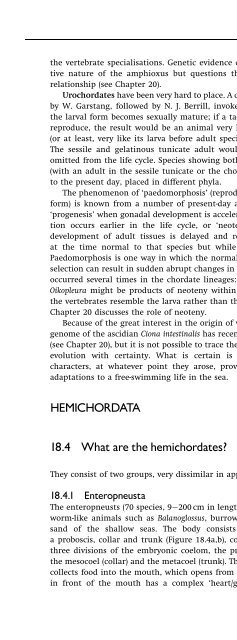An Introduction to the Invertebrates, Second Edition - tiera.ru
An Introduction to the Invertebrates, Second Edition - tiera.ru
An Introduction to the Invertebrates, Second Edition - tiera.ru
You also want an ePaper? Increase the reach of your titles
YUMPU automatically turns print PDFs into web optimized ePapers that Google loves.
WHAT ARE THE HEMICHORDATES?241<strong>the</strong> vertebrate specialisations. Genetic evidence confirms <strong>the</strong> primitivenature of <strong>the</strong> amphioxus but questions <strong>the</strong> closeness of <strong>the</strong>relationship (see Chapter 20).Urochordates have been very hard <strong>to</strong> place. A classic early accountby W. Garstang, followed by N. J. Berrill, invoked ‘neoteny’, where<strong>the</strong> larval form becomes sexually mature; if a tadpole larva were <strong>to</strong>reproduce, <strong>the</strong> result would be an animal very like <strong>the</strong> amphioxus(or at least, very like its larva before adult specialisations develop).The sessile and gelatinous tunicate adult would <strong>the</strong>n be entirelyomitted from <strong>the</strong> life cycle. Species showing both kinds of life cycle(with an adult in <strong>the</strong> sessile tunicate or <strong>the</strong> chordate form) survive<strong>to</strong> <strong>the</strong> present day, placed in different phyla.The phenomenon of ‘paedomorphosis’ (reproduction in <strong>the</strong> larvalform) is known from a number of present-day animals. It is called‘progenesis’ when gonadal development is accelerated and reproductionoccurs earlier in <strong>the</strong> life cycle, or ‘neoteny’ when somaticdevelopment of adult tissues is delayed and reproduction occursat <strong>the</strong> time normal <strong>to</strong> that species but while it is still a larva.Paedomorphosis is one way in which <strong>the</strong> normal process of naturalselection can result in sudden ab<strong>ru</strong>pt changes in form. It might haveoccurred several times in <strong>the</strong> chordate lineages: larvaceans such asOikopleura might be products of neoteny within <strong>the</strong> tunicates, and<strong>the</strong> vertebrates resemble <strong>the</strong> larva ra<strong>the</strong>r than <strong>the</strong> specialised adult.Chapter 20 discusses <strong>the</strong> role of neoteny.Because of <strong>the</strong> great interest in <strong>the</strong> origin of vertebrates, <strong>the</strong> fullgenome of <strong>the</strong> ascidian Ciona intestinalis has recently been sequenced(see Chapter 20), but it is not possible <strong>to</strong> trace <strong>the</strong> course of chordateevolution with certainty. What is certain is that <strong>the</strong> chordatecharacters, at whatever point <strong>the</strong>y arose, proved <strong>to</strong> be excellentadaptations <strong>to</strong> a free-swimming life in <strong>the</strong> sea.HEMICHORDATA18.4 What are <strong>the</strong> hemichordates?They consist of two groups, very dissimilar in appearance.18.4.1 EnteropneustaThe enteropneusts (70 species, 9 200 cm in length) are large solitaryworm-like animals such as Balanoglossus, burrowing in <strong>the</strong> mud orsand of <strong>the</strong> shallow seas. The body consists of three regions,a proboscis, collar and t<strong>ru</strong>nk (Figure 18.4a,b), corresponding <strong>to</strong> <strong>the</strong>three divisions of <strong>the</strong> embryonic coelom, <strong>the</strong> pro<strong>to</strong>coel (proboscis),<strong>the</strong> mesocoel (collar) and <strong>the</strong> metacoel (t<strong>ru</strong>nk). The ciliated probosciscollects food in<strong>to</strong> <strong>the</strong> mouth, which opens from <strong>the</strong> collar. The lobein front of <strong>the</strong> mouth has a complex ‘heart/glome<strong>ru</strong>lus’ system,











